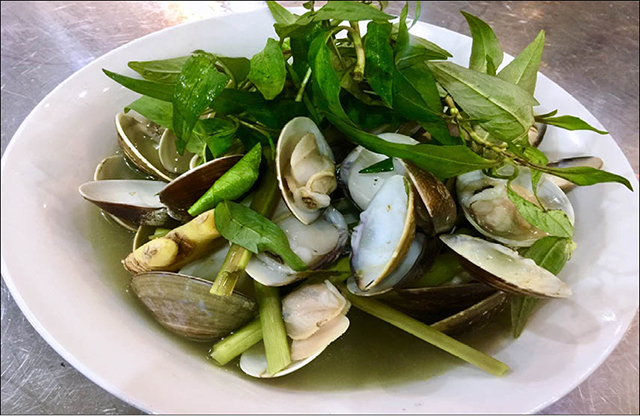
Ngao bung steamed with lemongrass
I am sure that Ngao bung (or tria mo, ngao mat, ngao lua) are the names being used by people in my village only. It is a kind of clams which are washed ashore every summer. Along the North Central Coast, the sight of people walking backwards collecting clams is so prevalent. My village is no exception. But it was only in the past, when young men and women equipped themselves with a rake. It was a long bamboo stick diverging at one end to form a triangle with a curved steel blade attached. A net bag was tied to the blade to contain clams.
Collecting clams looks simple but is hard work. People have to work early in the morning when the tide is still low. Along the waves, they wade in water up to their knees. They must bend down and push the rake into the sand about 5cm deep and walk backwards. When they hear the sound “crack” echoing from the rake, they know a clam has entered the net bag. As the tide rises, they have to go further from the beach.
We sat chatting. He reminded me of the words which I had not heard for a long time. “Do you still remember the word ‘coi’? How about ‘dui’?” asked he. In reality, “dui” clams is just for children who are new to the waves. They cannot carry such a long rake on their own; instead, they use their legs to “dui” the sand, searching for clams hiding deep in it. The shallow water which is tens of sai tay (the distance from one hand to the other when a person stretches their two arms) from the shore is called “coi”. When the tide rises, people have to swim to “coi” to collect clams.
Among many careers in the coastal region, collecting clams in the summer is a communal activity of the village by the sea. In the past, when clams were in season, we could see children “dui” clams near the shore while young men and women in queues walking backwards. It is an unforgettable sight to people living near the sea.
Clams are triangular in shape with rather thick shells of different colors such as gray, white, brown, etc. Small clams are those as big as two fingers while the big ones are about 4 fingers. Among the types of clams, ngao bung is considered a specialty rich in nutrition. Its flesh is quite thick, sweet and fragrant. In my village, clams are brought home and soaked in sea water for some hours to get rid of sand and then washed thoroughly. Boil water in a pot then drop them into it. When clam shells open up, the clams are ready to eat.
Nowadays, in restaurants clams are considered a specialty. They can be easily processed into various dishes such as clams grilled with fat and spring onion, clam sour soup, clams fried with garlic, clam porridge, etc. Clam shells with lots of calcium help cool down the body and treat sore throats, coughing and coughing with phlegm.
As for me, I like best clams steamed with lemongrass dipped in the sauce made from salt, pepper and lime juice. It looks simple but we can enjoy its salty flavor of the sea. As we were enjoying the dish, I figured out the recipe. Clams are first soaked in sea water or salt water to get rid of sand. After that, pour them into a pot with crushed lemongrass. Add in some chilli as well as spices to your taste and then steam for about 15 to 20 minutes until their shells open up and secrete the sweet juice.
Enjoying clams steamed with lemongrass, you might accidentally find some sand in it. Afraid that it might annoy him, I comforted “Clams live down on the sea bottom, no wonder you find sand in it. In the past, people had to expose themselves to the sun for half a day until their skin got burnt. Now and then they were pushed away by the waves only to collect just some kilograms of clams. Eating some grains of sand, people will feel sympathetic with lives by the sea”.
Story and photos: L. Thọ